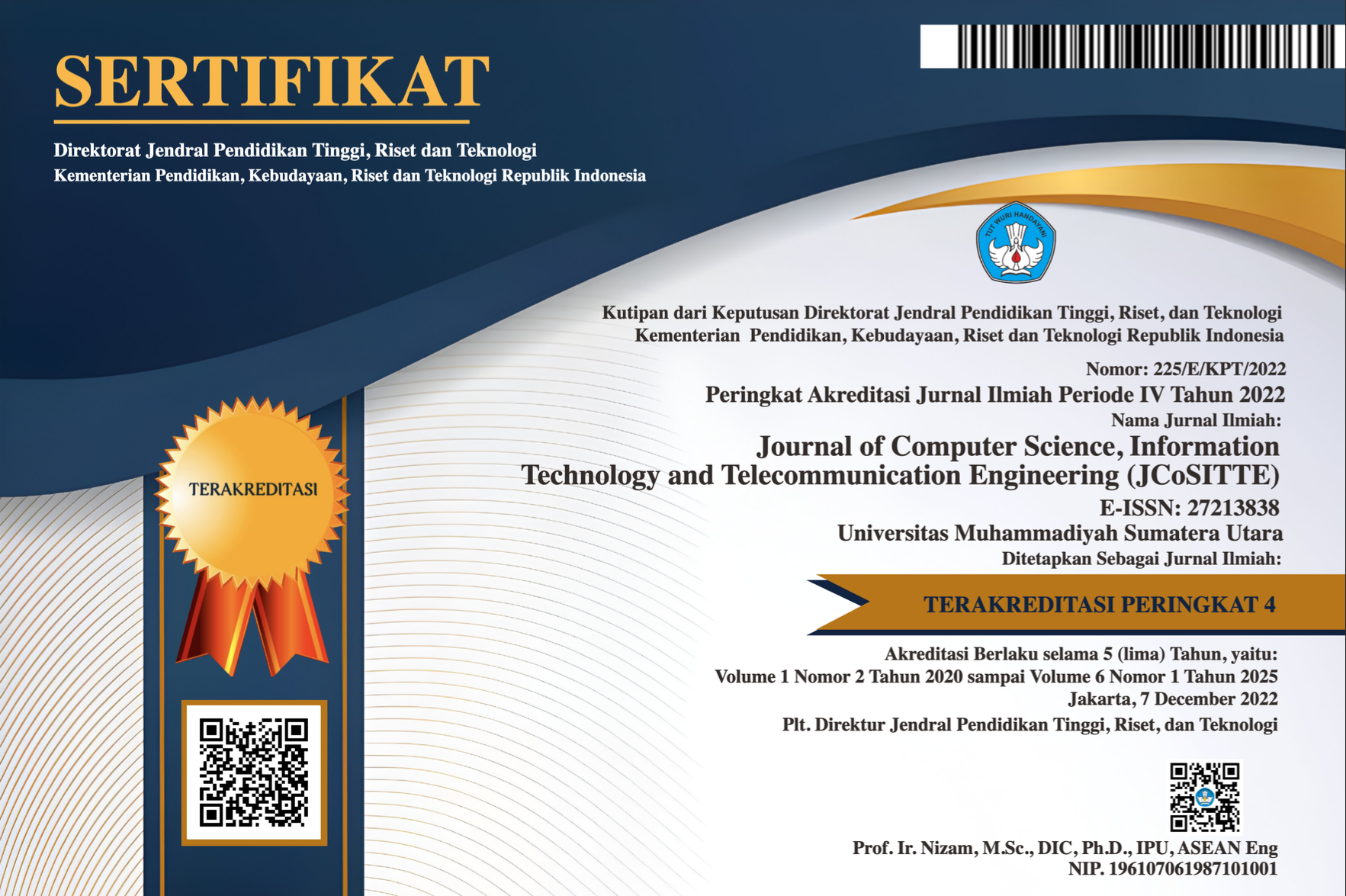Analysis of Pneumatic Systems Using the Laplace Equation Based on Python Programing
Abstract
Analysis for Pneumatic Systems using the Python programming language on Google Colab has been carried out. The steps taken before the simulation are to design a pneumatic system and then determine the Laplace equation based on Bernoulli's law equation. The Python programming language on Google Colab was chosen because it allows users to type Python code in a web browser and can be used for free. The simulation is carried out by varying the value of capacitance (C) from 50 kPa - 300 kPa with an increase of 50 kPa. This aims to determine the effect of changes in capacitance variations on the pressure exerted on the pneumatic system. Based on the simulation results, the greater the capacitance variation given, the resulting graph will be more sloping or closer to the x-axis. The C = 50 kPa variation has a steeper graph, while the C = 300 kPa variation has a more sloping graph and is closer to the x-axis.
Keywords
Full Text:
PDFReferences
Al-Dhaifallah, M., Kanagaraj, N., & Nisar, K. S. (2018). Fuzzy fractional-order PID controller for fractional model of pneumatic pressure system. Mathematical Problems in Engineering, 2018, 1–9. doi:https://doi.org/10.1155/2018/5478781
Bisong, E., & Bisong, E. (2019). Kubeflow and kubeflow pipelines. Building Machine Learning and Deep Learning Models on Google Cloud Platform: A Comprehensive Guide for Beginners, 671–685. doi:https://doi.org/10.1007/978-1-4842-4470-8
Boland, B. L., Xu, S., Wood, B., & Tse, Z. T. (2019). High speed pneumatic stepper motor for MRI applications. Annals of biomedical engineering, 47, 826–835. doi:http://doi.org/10.1007/s10439-018-02174-0
de Freitas, A. G., de Oliveira, V. F., dos Santos, R. B., Riascos, L. A., & Zou, R. (2022). Optimization Method for Pneumatic Conveying Parameters and Energy Consumption Performance Analysis of a Compact Blow Tank. Journal of Pressure Vessel Technology, 144, 064504. doi:https://doi.org/10.1115/1.4055111
Dong, J., Shi, J., Liu, C., & Yu, T. (2021). Research of pneumatic polishing force control system based on high speed on/off with PWM controlling. Robotics and Computer-Integrated Manufacturing, 70, 102133. doi:https://doi.org/10.1016/j.rcim.2021.102133
Fang, Y., Lu, Y., Yu, X., & Roskilly, A. P. (2018). Experimental study of a pneumatic engine with heat supply to improve the overall performance. Applied Thermal Engineering, 134, 78–85. doi:https://doi.org/10.1016/j.applthermaleng.2018.01.11
Harris, C. R., Millman, K. J., van der Walt, S. J., Gommers, R., Virtanen, P., Cournapeau, D., . . . Berg, S. (2020). Smith 474 nj. Kern R, Picus M, Hoyer S, van Kerkwijk MH, Brett M, Haldane A, del R’ıo JF, Wiebe M, Peterson P, G’erard-475 Marchant P, et al. Array programming with NumPy. Nature, 585, 357–362. doi:https://doi.org/10.1038/s41586-020-2649-2
Holohan, N., Braghin, S., Mac Aonghusa, P., & Levacher, K. (2019). Diffprivlib: the IBM differential privacy library. arXiv preprint arXiv:1907.02444. doi:https://doi.org/10.48550/arXiv.1907.02444
Khoirom, S., Sonia, M., Laikhuram, B., Laishram, J., & Singh, T. D. (2020). Comparative analysis of Python and Java for beginners. Int. Res. J. Eng. Technol, 7, 4384–4407.
Krasteva, V., Matveev, M., Jekova, I., & Georgiev, G. (2018). Heart rate variability analysis during weaning from mechanical ventilation: Models for prediction of the weaning trial outcome. 2018 Computing in Cardiology Conference (CinC), 45, pp. 1–4. doi:https://doi.org/10.22489/CinC.2018.113
Kuroki, M. (2021). Using Python and Google Colab to teach undergraduate microeconomic theory. International Review of Economics Education, 38, 100225. doi:https://doi.org/10.1016/j.iree.2021.100225
Leiden, A., Arafat, R., Callegari, M., Kolb, M., Herrmann, C., & Wichmann, H. (2023). Development and testing of novel mineral oil-and biocide-free glycerol-and propanediol-based fluids for drilling and tapping aluminium alloys. The International Journal of Advanced Manufacturing Technology, 126, 2323–2336. doi:https://doi.org/10.1007/s00170-023-11282-7
Leszczynski, J. S., & Grybos, D. (2019). Compensation for the complexity and over-scaling in industrial pneumatic systems by the accumulation and reuse of exhaust air. Applied Energy, 239, 1130–1141. doi:https://doi.org/10.1016/j.apenergy.2019.02.024
Makiyama, Y., Wang, Z., & Hirai, S. (2020). A pneumatic needle gripper for handling shredded food products. 2020 IEEE International Conference on Real-time Computing and Robotics (RCAR), (pp. 183–187). doi:https://doi.org/10.1109/RCAR49640.2020.9303279
Merzvinskas, M., Bringhenti, C., Tomita, J. T., & De Andrade, C. R. (2020). Air conditioning systems for aeronautical applications: a review. The Aeronautical Journal, 124, 499–532. doi:https://doi.org/10.1017aer.2019.159
Mu, S., Goto, S., Shibata, S., & Yamamoto, T. (2019). Intelligent position control for pneumatic servo system based on predictive fuzzy control. Computers & Electrical Engineering, 75, 112–122. doi:https://doi.org/10.1016/j.compeleceng.2019.02.016
Nehler, T. (2018). Linking energy efficiency measures in industrial compressed air systems with non-energy benefits–A review. Renewable and Sustainable Energy Reviews, 89, 72–87. doi:https://doi.org/10.1016/j.rser.2018.02.018
Peirce, J. W. (2007). PsychoPy—psychophysics software in Python. Journal of neuroscience methods, 162, 8–13. doi:https://doi.org/10.3758/s13428-018-01193-y
Ren, H.-P., Fan, J.-T., & Kaynak, O. (2018). Optimal design of a fractional-order proportional-integer-differential controller for a pneumatic position servo system. IEEE Transactions on Industrial Electronics, 66, 6220–6229. doi:https://doi.org/10.1109/TIE.2018.2870412
Ren, H.-P., Wang, X., Fan, J.-T., & Kaynak, O. (2019). Fractional order sliding mode control of a pneumatic position servo system. Journal of the Franklin Institute, 356, 6160–6174. doi:https://doi.org/10.1016/j.jfranklin.2019.05.024
Sakai, A., Ingram, D., Dinius, J., Chawla, K., Raffin, A., & Paques, A. (2018). Pythonrobotics: a python code collection of robotics algorithms. arXiv preprint arXiv:1808.10703. doi:https://doi.org/10.48550/arXiv.1808.10703
Sénac, T., Lelevé, A., Moreau, R., Novales, C., Nouaille, L., Pham, M. T., & Vieyres, P. (2019). A review of pneumatic actuators used for the design of medical simulators and medical tools. Multimodal Technologies and Interaction, 3, 47. doi:https://doi.org/10.3390/mti3030047
Sharma, A., Khan, F., Sharma, D., & Gupta, D. S. (2020). Python: The Programming Language of Future. INTERNATIONAL JOURNAL OF INNOVATIVE RESEARCH IN TECHNOLOGY, 6(12). Retrieved from https://ijirt.org/Article?manuscript=149340
Shi, Y., Cai, M., Xu, W., & Wang, Y. (2019). Methods to evaluate and measure power of pneumatic system and their applications. Chinese Journal of Mechanical Engineering, 32, 1–11. doi:https://doi.org/10.1186/s10033-019-0354-6
Smith, D. G., Burns, L. A., Simmonett, A. C., Parrish, R. M., Schieber, M. C., Galvelis, R., . . . others. (2020). PSI4 1.4: Open-source software for high-throughput quantum chemistry. The Journal of chemical physics, 152. doi:https://doi.org/10.1063/5.0006002
Sun, Z., Shi, Y., Wang, N., Zhang, J., Wang, Y., & Xu, S. (2021). Mechanism and optimization of a novel automobile pneumatic suspension based on dynamic analysis. Electronics, 10, 2232. doi:https://doi.org/10.3390/electronics10182232
Vallat, R. (2018). Pingouin: statistics in Python. J. Open Source Softw., 3, 1026. doi:https://doi.org/10.21105/joss.01026
Walker, J., Zidek, T., Harbel, C., Yoon, S., Strickland, F. S., Kumar, S., & Shin, M. (2020). Soft robotics: A review of recent developments of pneumatic soft actuators. Actuators, 9, p. 3. doi:https://doi.org/10.3390/act9010003
Xu, Y., Zhang, H., Yang, F., Tong, L., Yan, D., Yang, Y., . . . Wu, Y. (2021). Experimental investigation of pneumatic motor for transport application. Renewable Energy, 179, 517–527. doi:https://doi.org/10.1016/j.renene.2021.07.072
Zhou, J., Han, X., Jing, S., & Liu, Y. (2020). Efficiency and stability of lump coal particles swirling flow pneumatic conveying system. Chemical Engineering Research and Design, 157, 92–103. doi:https://doi.org/10.1016/j.cherd.2020.03.006
DOI: https://doi.org/10.30596/jcositte.v4i2.16266
Refbacks
- There are currently no refbacks.





.png)

